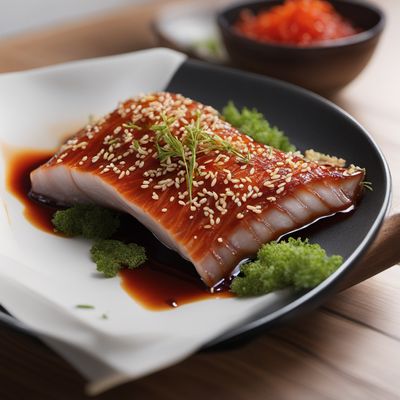
Ingredient
Fermented fish
The Savory Transformation: Unveiling the World of Fermented Fish
Fermented fish is a preservation technique that involves salting and fermenting fish, resulting in a unique flavor profile characterized by a pungent aroma, intense umami taste, and a tender yet slightly chewy texture. The fish undergoes a transformative process as the fermentation breaks down proteins and creates complex flavors, making it a prized ingredient in many traditional dishes.
Origins and history
Fermented fish has a rich history dating back thousands of years. It has been a staple in many cultures, including Southeast Asian countries like Thailand and Vietnam, where it is used in dishes like fish sauce and shrimp paste. In Scandinavia, fermented fish, known as surströmming, has been enjoyed for centuries and is often served with potatoes and onions. The preservation method of fermenting fish was developed as a way to preserve fish during long winters or for extended journeys at sea.
Nutritional information
Fermented fish is a good source of protein, omega-3 fatty acids, and minerals such as calcium and phosphorus. It is also low in calories and carbohydrates, making it a nutritious addition to meals.
Allergens
Fermented fish may contain allergens such as fish and shellfish, which can trigger allergic reactions in some individuals.
How to select
When selecting fermented fish, look for products that are well-packaged and sealed to ensure freshness. Check for any signs of spoilage, such as an off-putting odor or mold. Additionally, consider the reputation and quality of the brand or producer.
Storage recommendations
To maintain the freshness and quality of fermented fish, store it in a cool and dry place, preferably in the refrigerator. Keep it tightly sealed to prevent exposure to air, which can lead to spoilage. Consume it within the recommended shelf life mentioned on the packaging.
How to produce
Producing fermented fish at home requires expertise and careful handling to ensure safety. It involves salting the fish and allowing it to ferment in a controlled environment for a specific period. Due to the complexity and potential risks involved, it is recommended to learn from experienced individuals or purchase commercially produced fermented fish.
Preparation tips
When using fermented fish, it is important to consider its potent flavor. Start by adding small amounts to dishes, gradually increasing to achieve the desired taste. It can be used as a seasoning in soups, stews, stir-fries, or even as a condiment. Remember to adjust the saltiness of the dish accordingly, as fermented fish is naturally salty.
Culinary uses
Fermented fish is a versatile ingredient used in various cuisines. In Southeast Asian cooking, it is a key component in dishes like Thai green curry, Vietnamese nuoc mam, and Filipino bagoong. In Scandinavian cuisine, it is enjoyed as a topping on crispbread or incorporated into traditional dishes like surströmmingsskiva (fermented fish sandwich). Its intense flavor adds depth and complexity to sauces, marinades, and dressings.
Availability
Fermented fish is commonly available in Southeast Asian markets, Scandinavian countries, and specialty stores catering to international cuisines.
More ingredients from this category

Salt-preserved fish
The Savory Art of Salt-Cured Fish

Canned/jarred fish
The Ocean's Bounty in a Can

Structured/textured fish meat products or fish paste
The Versatile Delicacy: Structured/Textured Fish Meat Products or Fish Paste

Dried fish
The Umami Treasure

Smoked fish
"Savor the Delight: Exploring the World of Smoked Fish"

Marinated / pickled fish
The Tangy Delicacy from the Sea
Recipes using Fermented fish

Anhui-style Fermented Fish Rice
Tangy and Savory Anhui Fish Rice Delight

Funazushi Rolls
Umami Delight: Funazushi Rolls with a Twist

Grilled Fermented Skate (Hongeo) with Spicy Soy Sauce
Fiery Delight: Grilled Fermented Skate with a Spicy Soy Twist

Pembrokeshire-inspired Creamy Fish Stew with Fermented Fish Paste
Seafood Delight: Creamy Coastal Stew with a Pembrokeshire Twist